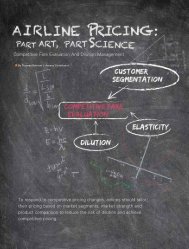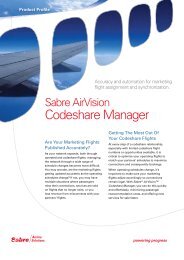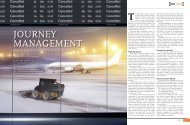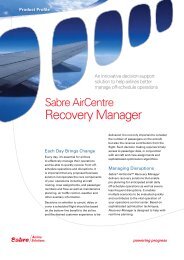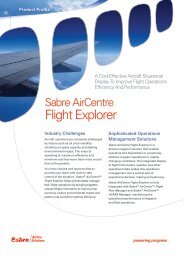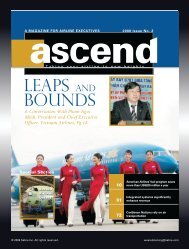2009 Issue 1 - Sabre Airline Solutions
2009 Issue 1 - Sabre Airline Solutions
2009 Issue 1 - Sabre Airline Solutions
You also want an ePaper? Increase the reach of your titles
YUMPU automatically turns print PDFs into web optimized ePapers that Google loves.
During its economically and environmentally significant flight last september, called AsPIre 1, Air New zealand saved approximately<br />
1,174 u.s. gallons of fuel and reduced co2 emissions by some 11,218 kilograms.<br />
Two basic necessities in the global air<br />
transport industry — saving fuel and<br />
reducing potentially environmentally<br />
harmful CO2 emissions — are linked directly to<br />
greater efficiency.<br />
And greater efficiency is precisely the<br />
goal that Air New Zealand has effectively targeted<br />
in its innovative application of advanced<br />
routing and flying procedures on its trans-<br />
Pacific route between New Zealand’s global<br />
economic hub in Auckland and the California<br />
coast at Air New Zealand’s North American<br />
destination in San Francisco.<br />
Considering the entire process, Air New<br />
Zealand has helped enable the aviation industry<br />
to make a leap forward in defining both a<br />
more environmentally friendly and economic<br />
means of operating aircraft over long transoceanic<br />
distances.<br />
On Sept. 12, Air New Zealand completed<br />
what is now recognized as an economically<br />
and environmentally significant flight of a<br />
Boeing 777-200ER aircraft from Auckland to<br />
San Francisco.<br />
Before and during this historically noteworthy<br />
flight called ASPIRE 1, Air New Zealand<br />
applied broad capabilities in the areas of<br />
advanced flight planning techniques, datalink<br />
communications and air traffic control advancements<br />
to reap highly impressive results in trip<br />
fuel savings totaling approximately 1,174 U.S.<br />
gallons as well as approximately 11,218 kilograms<br />
in reduced CO 2 emissions.<br />
Combined concerns revolving around<br />
global climate change, ongoing measurable<br />
ozone depletion and the overuse of natural<br />
resources (as represented by petroleum products)<br />
have intensified the sense of urgency<br />
felt by Air New Zealand executives to position<br />
themselves on the leading edge in identifying<br />
new operational methods for the carrier’s<br />
scheduled flights — especially flights across<br />
the vast distances of the Pacific Ocean.<br />
In coordination with innovative oceanic<br />
air traffic procedures, Air New Zealand has<br />
implemented advanced flight planning techniques<br />
to set a new standard in trans-Pacific<br />
travel.<br />
Air New Zealand determined that approximately<br />
42 percent of the total fuel savings on<br />
the Auckland-San Francisco flight is attributable<br />
to calculations and decisions derived from data<br />
supplied by Air New Zealand’s flight planning<br />
system, <strong>Sabre</strong> ® Dispatch Manager.<br />
The remainder of the credit for Air<br />
New Zealand’s significant achievement goes<br />
primarily to the most advanced air-navigation<br />
services provided by several government<br />
agencies, including Airways New Zealand,<br />
Airservices Australia and the U.S. Federal<br />
Aviation Administration.<br />
In incrementally analyzing Air New<br />
Zealand’s remarkable accomplishment, it’s<br />
important to examine the flight’s sequential<br />
process — from preflight stage through takeoff<br />
and climb, cruise, descent, and finally the<br />
flight’s landing at San Francisco International<br />
Airport.<br />
Air New Zealand uses Dispatch Manager<br />
to create optimized flight plans, which are then<br />
sent via datalink communications to an Air New<br />
Zealand aircraft cockpit’s flight management<br />
computer. This includes the flight plan itself,<br />
plus enroute wind and temperature data.<br />
The carrier is able to analyze historical<br />
fuel-burn data for each of its individual aircraft<br />
(compared to what was flight planned) and<br />
adjust its fuel-burn calculations accordingly for<br />
each aircraft, including calculation of a performance-deterioration<br />
allowance.<br />
To analyze this factor in proper context,<br />
the airline takes into account that as aircraft<br />
age, their fuel-burn performance is altered.<br />
Air New Zealand monitors the fuel-burn performance<br />
of each of its aircraft on a daily<br />
basis and makes weekly adjustments in its<br />
aircraft fuel-burn data. It also considers these<br />
measures a collective maintenance practice,<br />
which are followed to produce highly accurate<br />
flight plans based at least partly on the specific<br />
expected fuel-burn performance of each individual<br />
aircraft.<br />
As another key factor that results in<br />
highly accurate flight plans, Dispatch Manager<br />
receives an updated set of worldwide wind<br />
and temperature forecasts every six hours. Air<br />
New Zealand flight dispatch officers are then<br />
able to use these latest wind and temperature<br />
forecasts in the preflight planning stage to create<br />
the initial flight plan for any given flight’s<br />
departure.<br />
Further augmenting the flight-plan accuracy<br />
(as based on the most recent six-hourly<br />
wind and temperature data), Air New Zealand<br />
maintains various items of direct-operating-<br />
ascend<br />
Photo courtesy of Boeing<br />
13<br />
profile



